Can Roos Cancel Cancer?
 Tuesday, December 8, 2009 at 04:51AM
Tuesday, December 8, 2009 at 04:51AM  Photo by ScholzI love kangaroos. Macropods in general are really cool. Their reproductive biology, their fascinating social systems, the efficiency of their movement, they way they scratch themselves. Now researchers at the ARC Centre of Excellence for Free Radical Chemistry and Biotechnology think they have found a whole new reason to love roos – they might be able to repair DNA. Specifically DNA that - left unrepaired – is linked to cancer.
Photo by ScholzI love kangaroos. Macropods in general are really cool. Their reproductive biology, their fascinating social systems, the efficiency of their movement, they way they scratch themselves. Now researchers at the ARC Centre of Excellence for Free Radical Chemistry and Biotechnology think they have found a whole new reason to love roos – they might be able to repair DNA. Specifically DNA that - left unrepaired – is linked to cancer.
More than 1,700 people die of skin cancer each year in Australia alone, so this work Dr Linda Feketeová and Dr Uta Wille might turn out to be very important. Basically kangaroos (and other organisms, but not humans) produce an enzyme that is able to repair this particular type of DNA damage that has been linked to some skin cancers. Working with scientists from The University of Innsbruck, Austria, Drs Feketeová and Wille are hoping that a greater understanding of exactly how this process happens in kangaroos could lead to treatments or – better yet – preventative measures for humans.
There is there is the possibility of some sort of preventative treatment containing useful enzymes for use after significant sun exposure. Now that does sound ambitious, but let’s face it, we already slop on sun screan as a preventative measure. The idea of some sort of product that acts on a biochemical level is really cool, and this research is a step along that path. Thanks roos!
Heads Up
 Saturday, November 21, 2009 at 10:04PM
Saturday, November 21, 2009 at 10:04PM 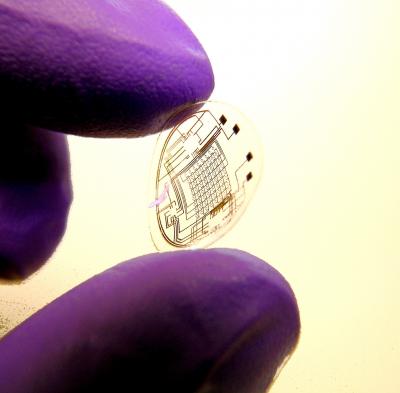 Image: University of WashingtonMany years ago a friend of mine turned up at our house with a new toy. It was basically a combat game and came complete with head-piece, vest and gun for each of 4 players. The gun “fired” some sort of signal – presumably infra-red – which was detected by sensors on the back, front and shoulders of the vest. As the number of shots inflicted upon you increased, you became more “injured” and eventually dead, just like in countless video games.
Image: University of WashingtonMany years ago a friend of mine turned up at our house with a new toy. It was basically a combat game and came complete with head-piece, vest and gun for each of 4 players. The gun “fired” some sort of signal – presumably infra-red – which was detected by sensors on the back, front and shoulders of the vest. As the number of shots inflicted upon you increased, you became more “injured” and eventually dead, just like in countless video games.
We proceeded to run about a local park hiding behind play equipment, hillocks and public toilets and taking shots at each other whenever we could. Other people in the park seemed rather bewildered as we ran, stumbled and giggled our way around them. We were in our twenties and I can only imagine what people thought when they emerged from the public toilet to come face to face with a young man in red goggles holding a gun.
I only remember playing this game once and I don’t think any of us were very good at it, possibly because we were distracted by the cool-ness of the head-up display in the head-piece. It was by this display that each player knew how dead they were becoming and what the team scores were.
Since then (and with added input from various science fiction movies) I have had a special place in my heart (and possibly corneas) for head-up displays. I have been quietly looking forward to the day when mobile phones and perhaps laptops could have their screens replaced by some sort of tiny virtual display. That day is a step closer with the announcement by Babak Parviz and his team at the University of Washington of a new contact lens embedded/imprinted with visual display circuitry. The idea is to produce images that appear to float between 50 cm and 1 metre in front of the user. More . . .
The Queen, the Flies and the Good Weekend
 Friday, November 13, 2009 at 11:58PM
Friday, November 13, 2009 at 11:58PM  It has been unseasonably warm in southern Australia recently. I haven’t really looked into the Bureau of Meteorology’s historical data, but my memory of November is of a month of bright sunny days, followed by rain, followed by wind, then more sun, then lots of cloud cover, etc, etc. Anyway, this current hot patch has had everyone talking about summer. Summer of course means flies. Great. Flies always remind me of a great Australian science story. It’s tale of science, of people and of times past. It’s true, its old and everyone should know about it.
It has been unseasonably warm in southern Australia recently. I haven’t really looked into the Bureau of Meteorology’s historical data, but my memory of November is of a month of bright sunny days, followed by rain, followed by wind, then more sun, then lots of cloud cover, etc, etc. Anyway, this current hot patch has had everyone talking about summer. Summer of course means flies. Great. Flies always remind me of a great Australian science story. It’s tale of science, of people and of times past. It’s true, its old and everyone should know about it.
It was a big deal when Queen Elizabeth visited Australia in 1963. The tour was scheduled between 18 February and 27 March – summer and peak fly season. More . . .
Friends and Fortunes, Farewells and Futures
 Saturday, November 7, 2009 at 01:53AM
Saturday, November 7, 2009 at 01:53AM  In Asakusa on Tuesday night we drew fortune chopsticks. Mitsuru reliably informs me that the one I drew is just about the best there is.
In Asakusa on Tuesday night we drew fortune chopsticks. Mitsuru reliably informs me that the one I drew is just about the best there is.
Bad old things will turn into happiness The bright lights of Asakusa
The bright lights of Asakusa
New hope appearing, you will get treasures
You can find hope on the cloud in the sky
Just like dead trees bloom flowers when spring comes
Everything will be prosperous
Apart from the fact that this translation is quite beautiful and the future is so positive, these were encouraging words to read as we all face the melancholy truth of our impending departure. Both Yuko and Mitsuru suggested that a clearer translation of the third line is to "aim high" (for the sky - beyond the clouds) which is also very uplifting.
We wandered about, ate food (fantastic again, of course), watched people, took photos, and there was a guy playing beautiful music near the temple. I'm not sure what the instrument was (could it have been a shakuhachi ?) but the music was peaceful and soothing. He was not busking - there was no hat, or bag or box - he was just playing. I wanted to thank him, but it did not seem appropriate.
Then we made off for dinner, followed by more farewells. By this point I had more or less given up trying to control my tear ducts when saying goodbye.
The following day some of us returned to Miraikan (and Cathy went off to buy 4 lovely Vivienne Westwood jackets). Miraikan had been our host organisation, but we had actually Hiromi and the GFP - Shimomura-san, Chalfie-san and Tsien-san would be pleased spent precious little time looking at its exhibitions. It was great to watch Hiromi doing a GFP (Green Fluorescent Protein presentation. I know we made her nervous, but she did a sterling job nonetheless.
Hiromi and the GFP - Shimomura-san, Chalfie-san and Tsien-san would be pleased spent precious little time looking at its exhibitions. It was great to watch Hiromi doing a GFP (Green Fluorescent Protein presentation. I know we made her nervous, but she did a sterling job nonetheless.
Patrick and I did a bit of shopping in the Miraikan shop, had fun in a virtual robot and had a closer look at the internet exhibition and the senses exhibition (excellent). We also enjoyed a super-conductor demonstration show and had a closer look at and the health and medical research section - also very good.
Through a bit of shared bungling and probably over-tiredness, we managed to mis-inform Yuko about or departure time, so she was unable to make it back for a final goodbye. That was a pity and Hiromi had to bear the burden of the final farewell, but we all know this is not the end. There are already emails flying about and all manner of plans to look up, hook-up and link-up. We can find hope - and fun - on the cloud in the sky.

Places to Go, People to See
 Wednesday, November 4, 2009 at 10:48PM
Wednesday, November 4, 2009 at 10:48PM 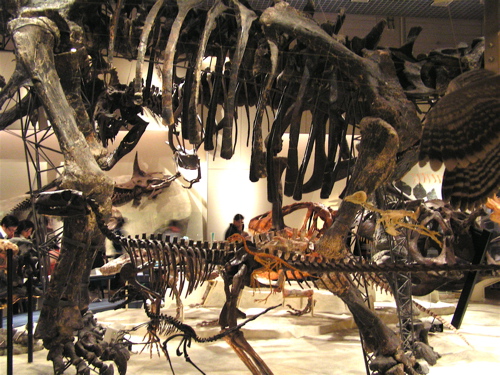 So bonyOn Monday and Tuesday we enjoyed a tour of science centres and musems in Toyko and there is quite a range. Tokyo National Museum of Nature and Science has a huge and spectacular collection. There are so many dinosaur skeletons that from some angles they seem to weave through each other. I can only imagine what they have in storage. There is also a roof top herb garden and a "parasol" garden featuring large umbrellas that open when you approach them. The roof space included solar panels, power supply substations, a variety of plumbing infrastructure and it could have remained for purely industrial purposes, but they've done great things with it, and the views into the surrounding park and across Tokyo are lovely. The Museum also has a beautiful biodiversity exhibition and the incredibly cool Theatre 360, a 12 metre sphere that one enters to experience a 360-degree
So bonyOn Monday and Tuesday we enjoyed a tour of science centres and musems in Toyko and there is quite a range. Tokyo National Museum of Nature and Science has a huge and spectacular collection. There are so many dinosaur skeletons that from some angles they seem to weave through each other. I can only imagine what they have in storage. There is also a roof top herb garden and a "parasol" garden featuring large umbrellas that open when you approach them. The roof space included solar panels, power supply substations, a variety of plumbing infrastructure and it could have remained for purely industrial purposes, but they've done great things with it, and the views into the surrounding park and across Tokyo are lovely. The Museum also has a beautiful biodiversity exhibition and the incredibly cool Theatre 360, a 12 metre sphere that one enters to experience a 360-degree 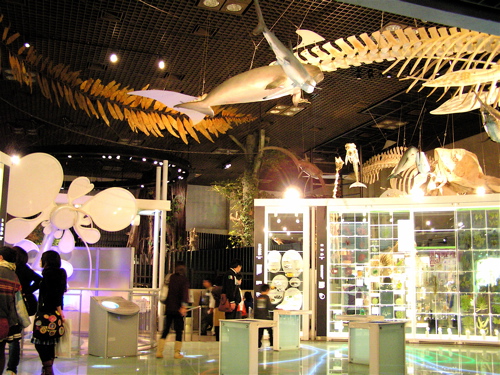 Beautiful biodiversity displaycinema screen.
Beautiful biodiversity displaycinema screen.
The Tokyo Science Museum (not to be confused with the Tokyo National Muesum of Nature and Science, above) also boasts an impressive range of themes and displays generally covering science and technology, as the name 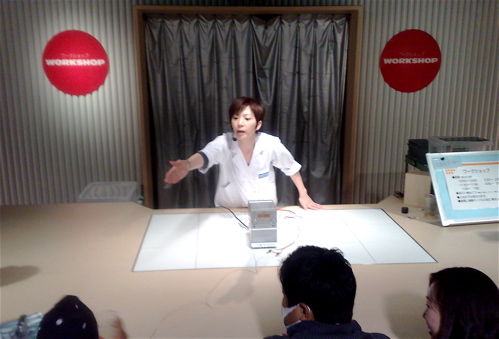 Madoka Suzuki in actionsuggests. If you like bikes, there's a great display of bicycle technology though history. The aurora section is very nice and we were treated to a lovely demonstration show about sound, presented by Madoka Suzuki, one of the 2008 Japan-Australia Science Exchange participants.
Madoka Suzuki in actionsuggests. If you like bikes, there's a great display of bicycle technology though history. The aurora section is very nice and we were treated to a lovely demonstration show about sound, presented by Madoka Suzuki, one of the 2008 Japan-Australia Science Exchange participants.
We also visited RiSuPia (I think they explained that 'ri' is the word for 'science', 'su' is the word for 'maths' and 'pia' is from the word for 'place)
the Panasonic Digital Network Museum. It's very fun.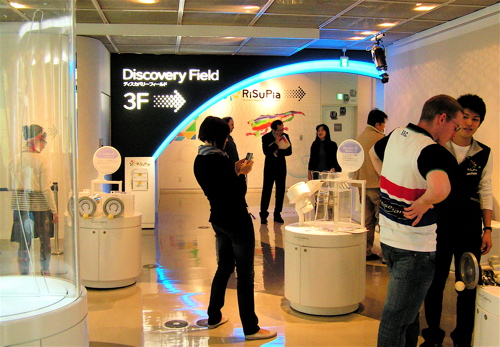 Ground floor at RiSuPia RiSuPia combines cool technology and simple concepts. The whole Centre is beautifully laid out and features interactive displays covering topics including perception, geometry, nano-chemistry, mathematics and the water cycle. Your experience is recorded on a personal electronic device worn around the next, which is updated as you move through the exhibits. I'd show you more of these, but cameras are not allowed beyond the 1st floor, so you'll just have to trust me, or go for yourself.
Ground floor at RiSuPia RiSuPia combines cool technology and simple concepts. The whole Centre is beautifully laid out and features interactive displays covering topics including perception, geometry, nano-chemistry, mathematics and the water cycle. Your experience is recorded on a personal electronic device worn around the next, which is updated as you move through the exhibits. I'd show you more of these, but cameras are not allowed beyond the 1st floor, so you'll just have to trust me, or go for yourself.
Our host organisation, Miraikan is focussed on cutting edge technologies and research. "Miraikan" actually translates (roughly) to "future house". It features exhibits such as the ever-changing (and fragile, so don't even think about launching a water rocket anywhere near it) geodome,  The fabulous Yuko, and some robot . . .some very nice nan-technology displays, the incredibly cool neutrino detector display and, of course Asimo. There is also a fantastic VR robot display. Basically 2 of you enter a VR theatre where you experience controlling a robot from inside (or on top of) it. The great thing is that you are actually controlling a real robot outside the room and seeing the world from its perspective. Patrick and I had a great time trying to meet the various bridge, ball and directional challenges posed by the Miraikan staff. These 4 institutions are wonderfully complimentary to one another and I'd recommend all of them.
The fabulous Yuko, and some robot . . .some very nice nan-technology displays, the incredibly cool neutrino detector display and, of course Asimo. There is also a fantastic VR robot display. Basically 2 of you enter a VR theatre where you experience controlling a robot from inside (or on top of) it. The great thing is that you are actually controlling a real robot outside the room and seeing the world from its perspective. Patrick and I had a great time trying to meet the various bridge, ball and directional challenges posed by the Miraikan staff. These 4 institutions are wonderfully complimentary to one another and I'd recommend all of them.
